 Space conceals many mysteries.
Space conceals many mysteries.
In its original sense of the Greek term “cosmos” was a philosophical basis for defining a hypothetical closed vacuum around the Earth center of the Universe. Clear boundaries — where space begins — does not exist, the atmosphere is gradually diluted as the distance from the earth’s surface, and still there is no consensus on what is considered the beginning of the space factor.
Cosmos often inspires artists to create an epic extraterrestrial paintings. Today, we’ll see.
1. Gliese 667 Cc — exoplanet in the habitable zone, the second exoplanet the star Gliese 667 C in the triple system Gliese 667. The planet is removed from the Earth at ~ of 22.7 light-years. So, in the artists ‘ opinion, can look like a sunset. (Photo by L. Calcada | Reuters | ESO):

2. In April 2011 the planetary system of the star OGLE-2005-BLG-390L was the most distant from the Sun of all the known planetary systems (21500 ±3300 light years). Planet is sparsely, which is drawn at an average distance of 2.6 a. E. from its star. The mass of the planet of 5.5 Earth masses. The surface temperature of the planet is estimated at only 50 K, since the parent star is a dim red dwarf.

3. Planet Kepler-16b with its two stars. Cool planet the size of Saturn, with a gas surface, is considered unsuitable for the origin of life. (Photo R. Hurt | Reuters | NASA):
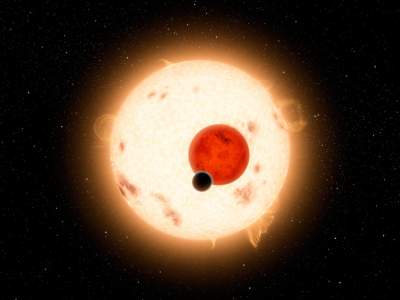
4. Astronomers have discovered more than 1284 planets outside our Solar system, 9 of them possibly habitable. (Photo Courtesy W. Stenzel | Reuters | NASA):

5. A supermassive black hole. (Photo by NASA):
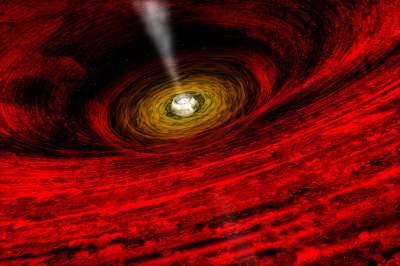
6. Imaginary view of the three planets orbiting cold “dwarf”. (Photo M. Kornmesser | N. Risinger | Reuters):

7. Solar system in our milky Way galaxy, located at a distance of about 1,000 light years from Earth in the constellation of Perseus. (Photo by Reuters | NASA | JPL-Caltech):

8. Kepler-22 b — exoplanet the star Kepler-22 in the constellation Cygnus. The radius of the planet is about 2.4 times the radius of the Earth; it is at the distance of about 620 light-years from Earth. Kepler-22 b like Neptune, consisting mainly of an extended atmosphere, ocean, and small solid core. (Photo NASA | Ames | JPL-Caltech):

9. Landing of Huygens probe on Saturn’s moon Titan. (Photo NASA | JPL | ESA):

10. The passage of the planet on the disk of its star. (Photo Bacon | Reuters | NASA):

11. Planet-like object, Sedna. One of the most distant known objects in the Solar system, with the exception of long-period comets. (Photo NASA | JPL-Caltech):

12. V838 of the Unicorn — the unusual variable star in the constellation of the Unicorn, a distance of about 20,000 light years (6 KPC) from the Sun. Luminosity 15,000 times the luminosity of the Sun. (Photo by Reuters | NASA):

13. Supermassive black hole, millions to billions times the mass of our Sun. (Photo NASA | JPL-Caltech):

14. Kepler-186 f — exoplanet in the planetary system of a red dwarf star Kepler-186 in the constellation Cygnus at a distance of 492 St. years from Earth. This is the first planet with a radius close to the earth discovered in the habitable zone of another star. (Photo NASA | JPL-Caltech):
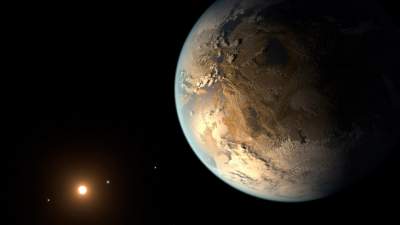
15. Earth-like planet UCF-1.01 is the closest to the Solar system. Vrascayuscyeisya around the red dwarf GJ 436 and removed from the Sun at 33 light years. The diameter and mass of the planet is about one-third of the earth that determines avtomaticheski the planet into a class of planets “mini-Land”. (Photo NASA | JPL-Caltech):

16. z8 GND 5296 galaxy discovered in October 2013 in the constellation URSA major. According to preliminary estimates, the light from this galaxy reaches the Earth is approximately 13 billion years. (Photo by NASA):

17. HAT-P-1 b — ekstremalnaya planet orbiting a yellow dwarf star ADS 16402 B is located at a distance of 450 light years from Earth in the constellation of the Lizard. Rather, it is a gas giant composed mainly of hydrogen and helium. (Photo By David A. Aguilar | Reuters):
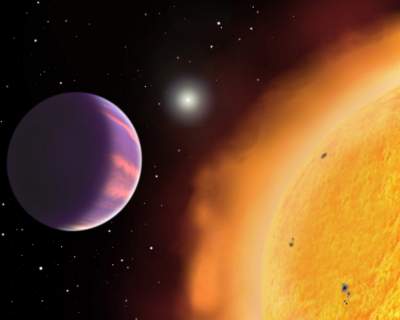
18. Another exoplanet (a planet revolves around a star, not a Sun), 6 times more Land. (Photo by L. Calcada/Reuters | ESO):
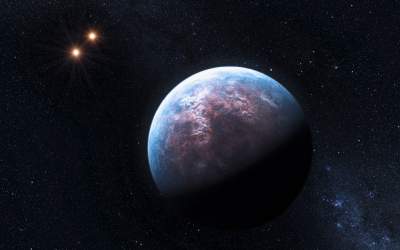
19. Planet Kepler-16 orbiting system of two stars. Located in the constellation of Cygnus at a distance of about 199 light years away. (Photo T. Pyle/Reuters | NASA):

20. The liquid on Titan (moon of Saturn) is represented by the natural pools on the surface of Titan, filled, presumably, with a mixture of liquid hydrocarbons, mainly methane and ethane. It depicts the formation of ice in hydrocarbon sea. (Photo by Reuters | NASA | JPL-Caltech):

21. A unique type of exoplanet discovered with the Hubble space telescope. The planet is so close to its star that makes a complete rotation in just 10.5 hours. (Photo A. Schaller | Reuters | NASA/ESA):

22. Imagine that you flew 270 thousand times more than the distance from the earth to the Sun. Here is Proxima planet orbiting the red dwarf Proxima Centauri, is related to the star system of alpha Centauri, the nearest star to Earth after Sun. Might look like the surface of this planet? Perhaps that is so. (Photo M. Kornmesser | Reuters | ESO):

23. HD 189733 A b — exoplanet, a bright blue gas giant in the constellation Chanterelles, in size comparable to Jupiter, orbits the orange dwarf star HD 189733 at A distance of 63 light-years from the Sun. The planet belongs to the class of so-called hot Jupiters — gas giants located very close to the Central star of the system. Because of the proximity to the parent star, HD 189733 A, b, and temperature up to 930 °C on the light side, and does not fall below 425 °C in the dark. (Photo M. Kornmesser | Reuters | ESA NASA):

24. Kepler-20 e — exoplanet that orbits the star Kepler-20, located in the constellation Lyra at a distance of about 950 light-years from us. (Photo NASA | Ames | JPL-Caltech):








